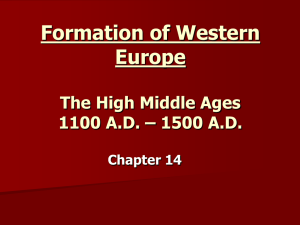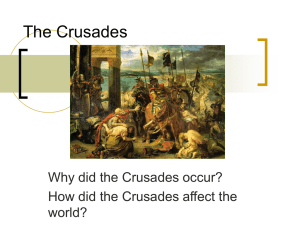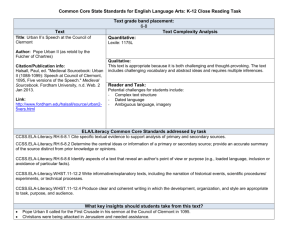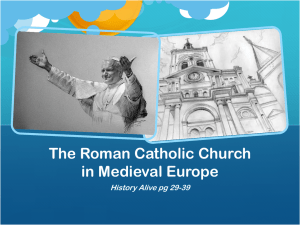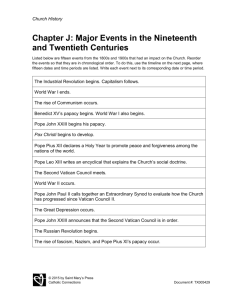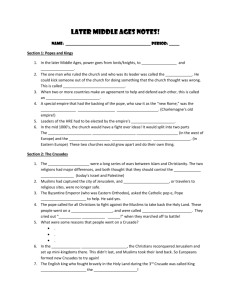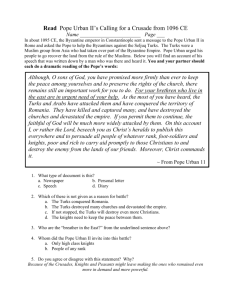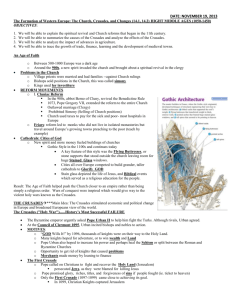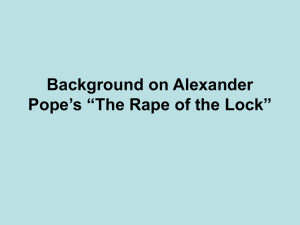The Formation of Western Europe By: Abraam Dawoud Church
advertisement
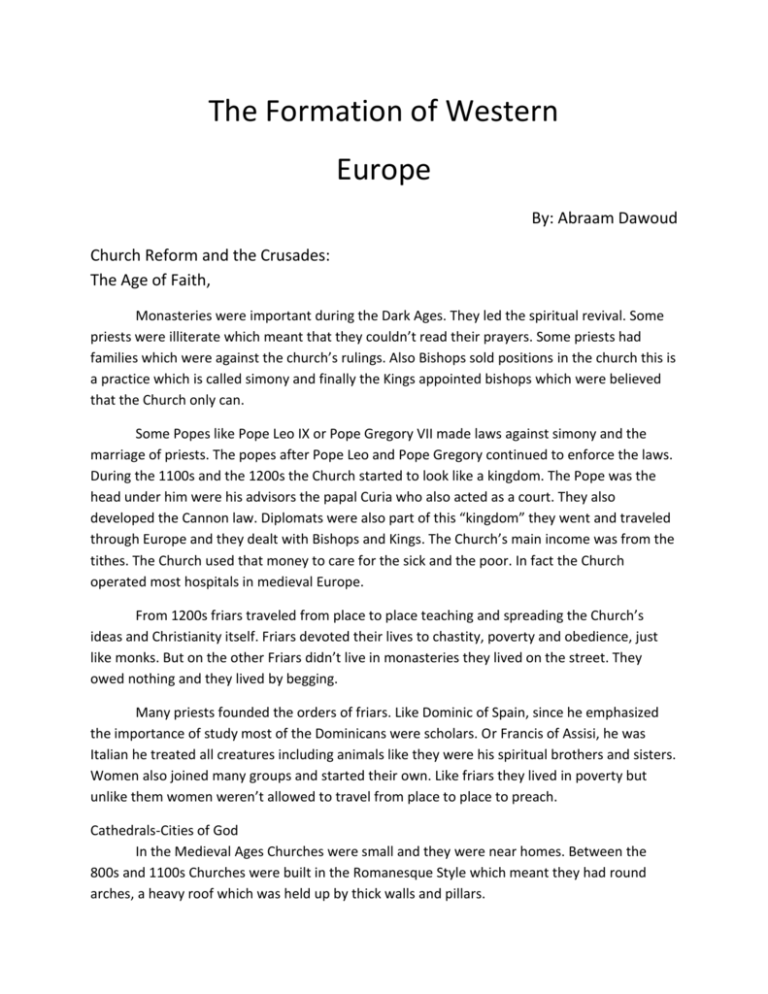
The Formation of Western Europe By: Abraam Dawoud Church Reform and the Crusades: The Age of Faith, Monasteries were important during the Dark Ages. They led the spiritual revival. Some priests were illiterate which meant that they couldn’t read their prayers. Some priests had families which were against the church’s rulings. Also Bishops sold positions in the church this is a practice which is called simony and finally the Kings appointed bishops which were believed that the Church only can. Some Popes like Pope Leo IX or Pope Gregory VII made laws against simony and the marriage of priests. The popes after Pope Leo and Pope Gregory continued to enforce the laws. During the 1100s and the 1200s the Church started to look like a kingdom. The Pope was the head under him were his advisors the papal Curia who also acted as a court. They also developed the Cannon law. Diplomats were also part of this “kingdom” they went and traveled through Europe and they dealt with Bishops and Kings. The Church’s main income was from the tithes. The Church used that money to care for the sick and the poor. In fact the Church operated most hospitals in medieval Europe. From 1200s friars traveled from place to place teaching and spreading the Church’s ideas and Christianity itself. Friars devoted their lives to chastity, poverty and obedience, just like monks. But on the other Friars didn’t live in monasteries they lived on the street. They owed nothing and they lived by begging. Many priests founded the orders of friars. Like Dominic of Spain, since he emphasized the importance of study most of the Dominicans were scholars. Or Francis of Assisi, he was Italian he treated all creatures including animals like they were his spiritual brothers and sisters. Women also joined many groups and started their own. Like friars they lived in poverty but unlike them women weren’t allowed to travel from place to place to preach. Cathedrals-Cities of God In the Medieval Ages Churches were small and they were near homes. Between the 800s and 1100s Churches were built in the Romanesque Style which meant they had round arches, a heavy roof which was held up by thick walls and pillars. In the early 1100s Gothic architecture evolved throughout Europe. Gothic comes from the Germanic tribe Goths. The Romanesque buildings were heavy and gloomy but Gothic Cathedrals upward as if they were reaching towards heaven. Light came in through huge stained windows. These elements were meant to inspire the worshiper and the magnificence of God. Gothic Cathedrals were built in a lot of towns in France. In Paris they had the Cathedral of Notre Dame. Between 1170 and 1270 500 Gothic Churches were built. The Crusades The Age of Faith inspired conquest. In 1093 the Byzantine Emperor Alexius Commenus sent a letter to Robert the Count of Flanders. The Muslim Turks were threatening to conquer his capital, Constantinople. Pope Urban II read the letter and he issued a “Holy War” which meant a Crusade to gain control of the holy land. In 300 years numerous Crusades were launched. The Crusades did not only have a religious motive but it also had economic, political and social goals. The Muslims controlled Palestine which is the Holy land and the Muslims were also threatening Constantinople. When the Byzantine emperor asked for help the Pope agreed, he also wanted to reclaim Palestine and reunite Christendom. The pope and the king saw the Crusades as a chance to get rid of quarrelsome knights. The knights had threatened the peace of the kingdoms and Church property. Most of the Crusaders were the younger sons of a family. Since being the oldest son he inherits all the fathers’ property so the young sons went looking for land a position in society and adventure. Merchants made money by financing the journey. They leased ships for a hefty fee to transport armies. Pope Urban said those who died on a Crusade were assured a place in heaven. The knights and commoners wore red crosses over their armor and they had a battle cry of “God wills it” By early 1097 three armies stood outside of Constantinople. Most of the Crusaders were French but Bohemians, Germans, Englishmen, Scots, Italians and Spaniards came as well. The first Crusade wasn’t prepared. They knew nothing about the geography, climate or the culture of the Holy Land. They also didn’t have a plan to capture it but on July 15, 1099 they captured the city. Now the Crusaders won a narrow strip of land 650 miles in total from Edessa in the north to Jerusalem in the south. The Crusaders were extremely vulnerable to Muslim counterattack. In 1144 Edessa was reconquerd by the Turks. In 1187, Europeans were shocked to learn they Jerusalem itself had fallen to a Kurdish warrior and Muslim leader Saladin. The third crusade to recapture Jerusalem was led by 3 monarchs, Philip II of France Frederick I of Germany and Richard the Lion-Hearted. Philip fought with Richard and Philip went home. Then Barbarossa drowned. It was only Richard verses Saladin after many battles they agreed to truce. Jerusalem is to stay under Muslim control but Saladin promised that unarmed Christian pilgrims could freely visit the city’s holy places. The Crusading Spirit Dwindles In 1204 the Fourth Crusade to capture Jerusalem failed. The knights didn’t reach the Holy Land so they ended up looting Constantinople. During the 1200s for more Crusades were launched none were successful. Two more were launched not into the Holy Land Palestine but Egypt. They wanted to weaken the Muslim forces then take Palestine over but this did not work. Their was even a Children Crusade which was led by 12-year old Stephen of Cloyes in 1212. An estimate of 30,000 children under the age of 18 joined him. Many died from cold and starvation and the rest either drowned or they were sold into slavery. Nicholas of Cologne gathered 20,000 children and young adults but most of them died crossing the Alps. Those who survived meet the pope who told them to go back home only 2,000 people survived the return trip. In Spain the Moors controlled most of Spain until the Reconquista which was long effort by the Spaniards to drive out the Muslims out of Spain. By the late 1400s the Muslims held only Granada and in 1492 Granada fell to the army of King Ferdinand and Queen Isabella. To unify their country Isabella made the use of Inquisition which was a court held by the church to suppress heresy. In 1492 the monarchs expelled all practicing Jews and Muslims from Spain. The effects of the Crusades The failure of later Crusades weakened the power of the pope. Feudal Nobility increased the power of the King. The fall of Constantinople weakened the Byzantine Empire intolerance and prejudice displayed by Christians in the Holy Land left behind a legacy of bitterness and hatred. The Crusades grew out of religious fervor, feudalism, and chivalry. A Growing Food Supply Expanding a civilization required an increased food supply and a warmer climate came during the 800s up until the 1200s which brought improved farm production. For centuries peasants needed Oxen to plow their cars. But now horses replaced them. Horses can plow three times as much land in a day as a team of oxen. In the 800s the three-field system was used. Farmers could grow crops on 2/3’s of the land each year not on half of it. Therefore food production increased. The Guilds A guild was an organization of individuals in the same business or occupation working to improve economic and social conditions. Merchants also banded together to control the number of goods being traded and to keep prices up. Guilds set standards of quality of their work, wages and working conditions. By the 1100s artisans and craftspeople were manufacturing goods for trade. The Guilds became powerful forces in the medieval economy. Commercial Revolution Commercial Revolution- is the expansion of trade and business. Most of the trade took place in towns. On fair days peasants from Manors traveled to towns carrying goods to trade. Fairs were held several times a year usually during religious festivals when most of the people were in town. Most of the common items for sale were cloths, bacons, salts, honeys, cheeses, wines, leathers, and ropes. Trade roots spread through Europe and merchants reinvested the profits in more goods. Bills or exchange were established so were letters of credit- A letter issued by a bank allowing the bearer to withdraw a specific amount of money from the bank or its branches. Merchants looked for new markets and opportunities to make a profit. The Church forbade Christians lending money at interest which was a sin called usury. Over time the church relaxed this rule that was when they Christians entered the banking system. Urban Life Flourishes Between the ages of 1000 and 1150 the population of Europe was believed to go from 30million to about almost 42million. Europe’s largest city was Paris and Paris had about 60,000. A typical town in Europe had only 1,500 to 2,500 people. But there were drawbacks in living in a medieval town. The streets were narrow and full of human and animal waste. Houses were made of wood so they were a constant fire hazard. As trade expanded, the burghers-merchantclass town dwellers, resented thus interference in their trade and commerce. The Revival of Learning During the crusades contacts with the Muslims and the Byzantines increased greatly. This brought a new interest in learning the works of Greek philosophers. In the 1100s Christian Scholars translated these works from Arabic to Latin. The Crusaders brought back to Europe superior Muslim technology in ships, navigation and weapons. At the middle of growth and learning a university formed. Universities arose in Paris and Italy later on Oxford England. For most students their jobs were in the government or the Church. A few poets used vernacular- or the everyday language of their homeland. Some the poems are still read today like The Divine Comedy by Dante Alighieri. Christians were excited by the ideas of Greek Scholars. In the 1250s Thomas Aquinas argued that the most basic religious truths can be proved by logical argument, he wrote the Summa Theologicae. Scholastics- School men. The scholastics used their knowledge of Aristotle to debate many issues of their time. England and France Develop In the 800s, Britain was under constant attacks by the violent Danish Vikings. They were so feared that the Brits had a special prayer that said “God, deliver us from the fury of the Northmen. Alfred the Great an Anglo-Saxon King from 871 to 899 managed to turn back the Vikings. Slowly his successors had united the kingdom under one rule calling England “Land of the Angles” In 1016 Canute the Danish King conquered England blending the Anglo-Saxon and Vikings into one people. King Edward the confessor took the throne and he died in January 1066 without an heir leading to one last invasion. That invader was William, the duke of Normandy who later became known as William the Conqueror. Its name came from the French term for Vikings-North men or Norman. His rival was Harold Godwinson. On October 14, 1066 the Normans and the Anglo-Saxon fought at the Battle of Hastings. Harold was killed by an arrow that pierced his eye. After his victory William declared all England his property and William kept one- fifth of England. The lords who supported Harold lost their lands. William unified control of the lands and laid the foundation for centralized government in England. His successors owned both Normandy and England. The England Henry II added to these holdings by marrying Eleanor of Aquitaine from France. Henry Ruled from 1154 to 1189. Henry introduced the use of Jury. A jury consisted of 12 neighbors of the accused who answered a royal judge’s question. When Richard the Lionhearted died his younger brother took the throne. His name was John; John was cruel to his subjects and tried to squeeze money out of them. He also higher taxes to help him finance his wars. On Junes 15, 1215 Nobles forced John to agree to the Magna Carta. Another important step toward the democratic government was Parliament which is a legislative group. From 1300 to 1400 AD the king called the knights and burgesses whenever a new tax was needed. Parliament had two groups the House of Commons and the House of Lords (Nobles and bishops). Capetian Dynasty Rules France The Kings of France wanted to increase their power. In the year 1000 France had 47 Feudal Territories. Hugh Capet was a duke from the middle of France succeeded Louis. One of the most powerful Capetians was Philip II. Philip increased the territory of France. Philips Grandson was Louis IX he was a pious saint. Louis created French Appeals court. The Hundred Years War and the Plague. In 1300s Pop Boniface VIII enforced papal authority on kings as previous popes had. When Philip IV of France asserted his authority over the French Bishops. Instead of obeying the Pope Philip captured him and held him prisoner the pope escaped but died one month later. Clement the new pope moved from Rome to Avignon in France. The Move weakened the Church. When there was a pope in Avignon and an Italian pope in Rome it caused the Great Schism. The Papacy challenged by an Englishman called John Wycliffe said Jesus was the head of the church, not the pope. He also thought the Church should not own land of have possessions and the Bible was the final ruling, not the pope. He also made an English translation of the New Testament. Jan Hus a professor taught that the authority of the Bible was higher than the pope. He was excommunicated, and later seized as a heretic and burned at the stake. During the 1300s the Bubonic Plaque broke out. The plague began in Asia and spread to Europe. The effects of the Plague was that- Town Population fell, Trade declined.-The serfs left the manor- Jews were blamed for the plague. The church suffered loss when its prayers failed to stop the onslaught of the bubonic plague and priests abandoned their duties. When the last Capetian king died without an heir Edward III claimed the French Throne .The Hundred Years war was from 1337 to 1453. This wart changed warfare in Europe . The English introduced the longbow . A teen, French, peasant girl named Joan of Arc felt moved by God to protect France from English rule. In her dreams she thought she heard the voices of saints telling her to make sure Charles VII got the crown when Charles VI died .She marched the French army to Orleans, but the path way blocked by a fort. They fought a battle and the French retreated. But Joan and a few soldiers charged the fort and broke in. They continued on the path of victory. She had Charles VII crowned. The Burgundies captured Joan and turned her over to the English. The English turned her over to the Church. Charles VII did nothing to help her (typical man). She was burned at the stake.
